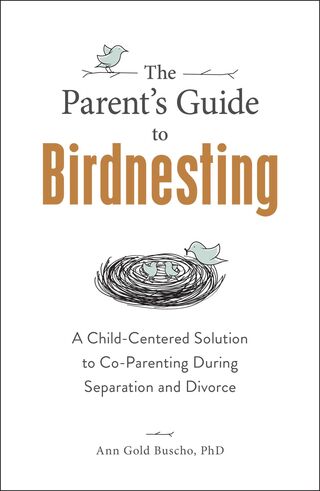Divorce
Book Review: The Parent's Guide to Birdnesting
The child-centered divorce method Mr. Rogers would approve of.
Posted December 31, 2020

Sometimes, truly disruptive books aren’t the ones that propose bold new ideas or change our paradigm. Sometimes, the truly disruptive books are the ones that provide us a step-by-step process towards achieving the changes we’re trying to make. That was my impression when reading A Parent’s Guide to Birdnesting by Ann Buscho. It’s not that "Birdnesting" is such a new or innovative way to manage divorce—it’s been around for years—it’s that Dr. Buscho created such a detailed, step-by-step plan for exactly how to manage it.
In this carefully thought-out and meticulously planned book, every practical consideration a parent might need to consider before entering a Birdnesting agreement is laid out. First, we hear about the history and evolution of Birdnesting as a divorce choice, as well as the author’s own history using this arrangement. The most compelling argument for Birdnesting appears to be that since the adults are largely the ones making the decision and the change, shouldn’t they be the ones to bear the brunt of the discomfort?
Let’s face it, some of the destabilizing effects of divorce on kids are due to the need to move from home to home, always leaving something or someone behind, and the unsettling feeling of not really having one permanent place to be. If that entire concern is removed from a child’s experience of divorce, it frees the child to deal with the more difficult aspects of divorce, to move on, and to heal. By putting the onus of the “moving around” on the adults, kids are spared the entire logistical mess of custody arrangements. (To learn more about the Birdnesting approach, click here for Dr. Buscho's website. To read Dr. Buscho's Psychology Today blog, click here.)
The book then covers—in incredibly useful detail—every single practical consideration that may come up when making this arrangement. Every single conceivable roadblock—from finances to religious differences to disagreements on disciplinary styles or even amount of screentime kids get—is laid out for discussion. This way, if parents are going through mediation or working with a parenting coordinator, these conversations can happen well in advance of the problem.
In general, when disagreements crop up suddenly or when we’re under pressure to resolve them, we tend to decompensate. When Mom believes in a vegan, clean-eating lifestyle, and she comes home to find her kids chowing down on junk food and burgers, that’s a recipe for an explosion. In the mediator’s office or in a calm, adult discussion, parents can resolve this type of disagreement and come up with a set of operating principles, like “Daddy gets to choose the menu when he’s the parent on call; Mommy gets to do the same when she’s on call.” Or, “Since Mommy does the bulk of the cooking and is upset by having animal products in the kitchen she uses, if Daddy wants to serve meat, it should be done outside of the home….” Etc. When we’re not hit by surprise, we tend to react better.
Similarly, situations like long-term projects for children can be discussed in advance. It’s unfair for one parent to be hit with “You need to help me with my entire science fair project—I’m constructing a working model of the human heart out of paper mache and a remote-control car’s engine—and you need to help me do it by tomorrow!” These types of long-term projects can be managed if they’re thought out in advance, with each parent’s responsibilities clearly laid out.
It’s that level of detail—finances, chores, household repairs, doctor’s appointments, playdates, college funds—that makes this book truly disruptive because any conceivable situation has been thought of, and a series of detailed prompts and questions are provided, so the parents can sit down and plan for all of these potential hotspots in advance. Let’s face it—many divorcing couples haven’t historically been great at problem-solving together, so taking the guesswork out of it is likely to be extremely helpful.
Similarly, some hot-button topics are discussed, such as when the “on-call” parent brings a date into the home—at what stage of a relationship are both parents comfortable with this? What will be the ground rules around having a new person in the home? Can both parents tolerate seeing their ex with a new partner? With any potentially painful situation, preparation during a calmer time is key to success. This type of situation is no exception.
Finally, the book talks about some contraindications to Birdnesting—times that it simply cannot work. In situations of extreme high conflict, a couple who cannot be in the same room for even five minutes without raising their voices probably should not enter into this type of arrangement. Similarly, domestic violence or substance abuse are contraindications. Dr. Buscho also cautions about cross-cultural marriages, suggesting that both partners discuss their cultural differences around this before deciding if Birdnesting is right for them.
So many couples begin the divorce process saying, “The kids come first—we’re going to do what’s best for them,” and then completely do not live up to that value. Whether that’s due to the inherently conflictual nature of the divorce process or each parent’s individual psychological process, a truly child-centered divorce is a rarity. This book manages to lay the groundwork for that almost-mythical creature. If parents, parenting mediators, and therapists follow the steps laid out in the book, a child-centered divorce seems much more possible.
As a child psychologist, I personally have exclusion criteria for high-conflict divorces. I just can’t bear to witness what happens when a divorce is so contentious that no one thinks of the children. I became a child psychologist because I value giving children a healthy, normative childhood, and contentious divorce doesn’t allow for that.
But not every divorce has to become contentious. In writing this book, Dr. Buscho really provides the roadmap for creating a divorce agreement that is healthy and child-centered. I can see a couple using this book as a problem-solving guide to keep the conflict at bay and the children front-and-center. All I could think as I read the book was, “Wow, a truly child-centered divorce. Mr. Rogers would approve.”
References
Buscho, Ann. (2020).The Parent's Guide to Birdnesting: A Child-Centered Solution to Co-Parenting During Separation and Divorce. Avon, MA: Adams Media




